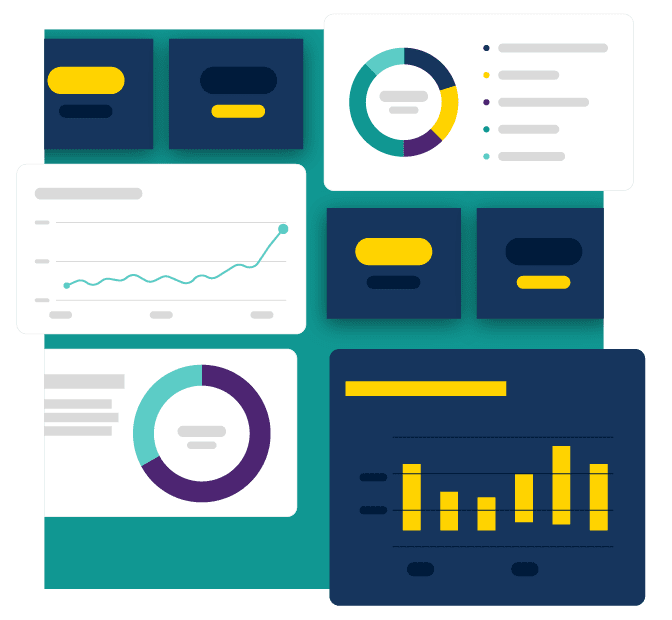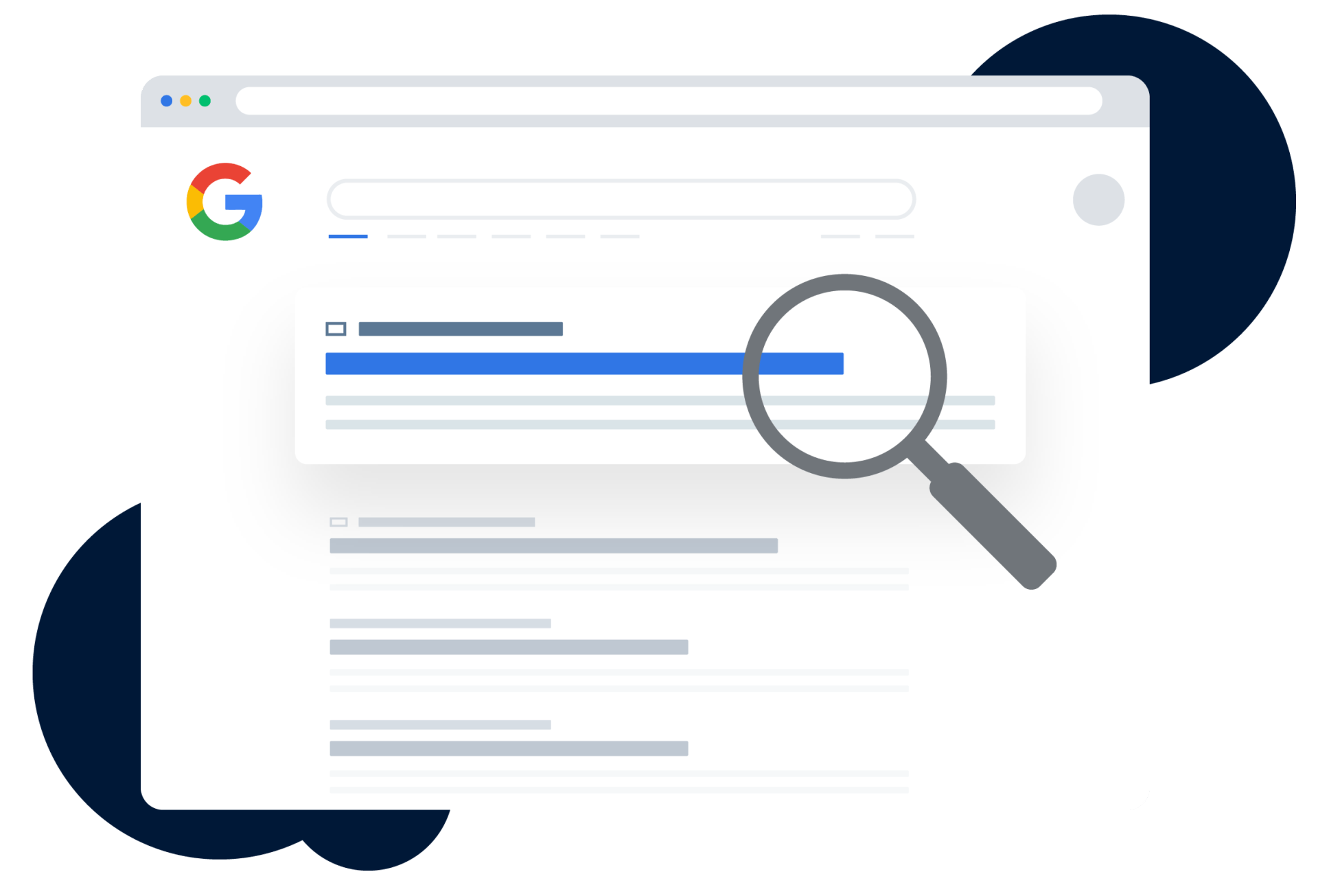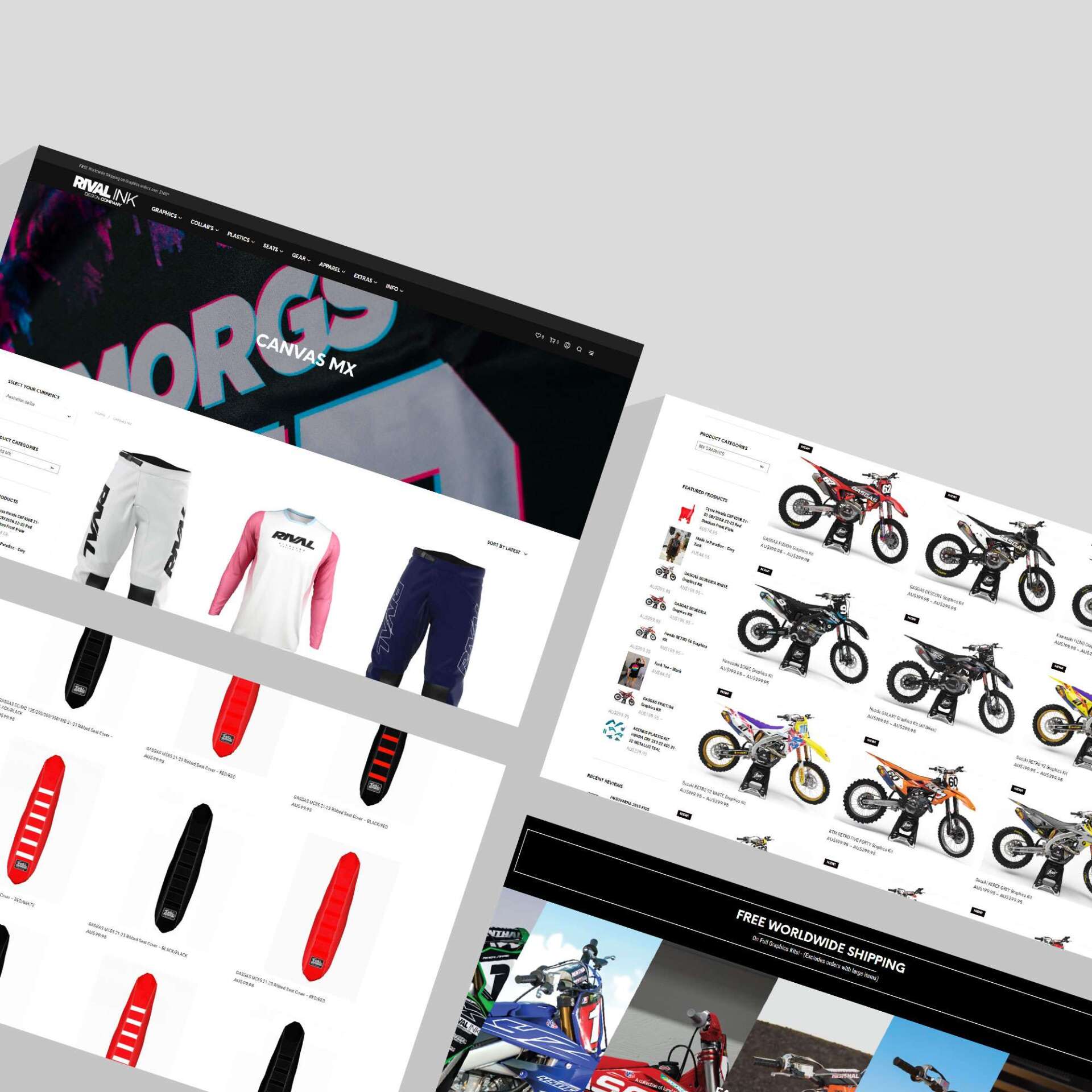Ad Fatigue 101: How to Keep Your Audience Engaged
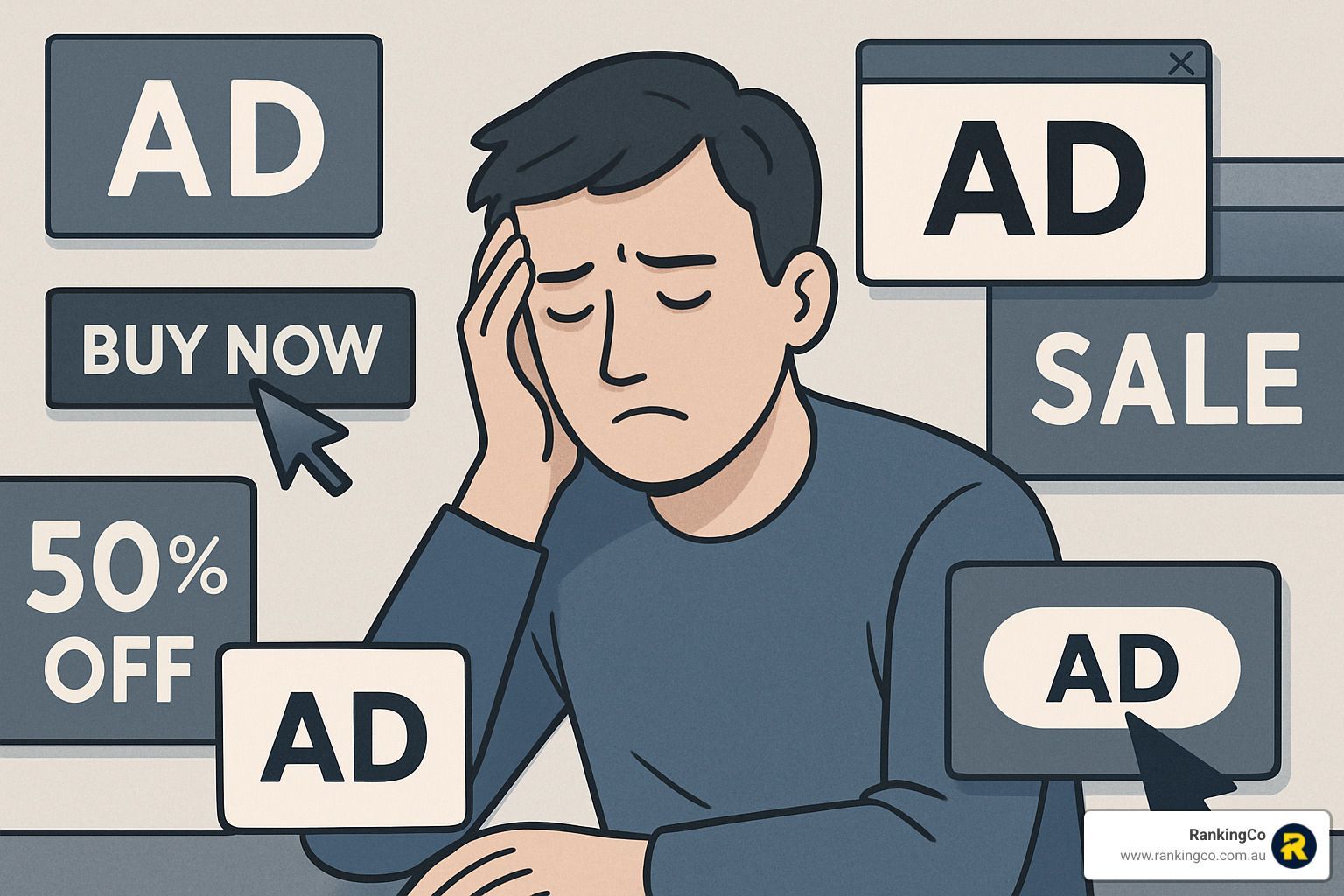
The Challenge of Audience Burnout
Ad fatigue occurs when your audience sees the same advertisements too frequently, causing them to become bored, annoyed, or completely blind to your messaging. This declining effectiveness leads to lower engagement, reduced click-through rates, and wasted ad spend.
What is ad fatigue?
- The declining effectiveness of ads due to repeated exposure to the same creative
- Typically shows up as dropping click-through rates and rising costs
- Begins when frequency exceeds 6-10 impressions per user
- Affects all platforms but particularly impacts Google Ads campaigns with high impression share
We've all experienced it—that moment when you've seen the same Google ad for the tenth time and your brain automatically filters it out. What started as an attention-grabbing message has transformed into background noise. For marketers, this phenomenon represents a serious threat to campaign performance and return on investment.
The average person encounters between 4,000 and 10,000 ads daily, creating an increasingly cluttered digital landscape where standing out becomes progressively harder. This challenge is particularly acute in Google Ads, where limited creative space and high competition can accelerate audience fatigue.
In Australia, where digital ad spend continues to grow year over year, businesses face the dual challenge of smaller audience pools and higher frequency rates—making strategic Google Ads management crucial for maintaining campaign effectiveness.
I'm Amber Porter, and throughout my years optimising Google Ads campaigns across Australia, I've developed proven strategies to combat ad fatigue and keep audiences engaged no matter how competitive your market becomes.
What Is Ad Fatigue in 2025?
In 2024, ad fatigue has evolved into something far more complex than simple audience boredom. It's now a multifaceted challenge that combines psychological responses, technological shifts, and sophisticated algorithms – all working together to diminish your advertising effectiveness.
The core concept remains the same – the declining impact of advertisements when people see them too often. But today's digital landscape has intensified this challenge significantly. With Australians spending over 6 hours daily online, we're creating more opportunities than ever for ads to wear out their welcome.
Modern ad fatigue takes several forms that marketers need to understand:
Banner blindness has become almost instinctual – our brains now automatically filter out content that appears in typical ad positions. Platforms like Google have implemented algorithmic down-ranking, where they actually reduce delivery of ads showing declining engagement. This happens alongside general screen fatigue, where digital overwhelm makes us all less receptive to advertising messages. And let's not forget the sheer marketing clutter – with thousands of competing messages diluting the impact of any single ad.
What makes the Australian market particularly challenging is our relatively smaller audience pools compared to global markets. When you're targeting specific demographics in cities like Brisbane or Perth, you can reach frequency saturation points alarmingly quickly – especially in niche industries or tightly geo-targeted campaigns.
The Psychology Behind Ad Fatigue
Understanding the psychological mechanisms behind ad fatigue helps explain why even your most brilliant creative eventually loses its punch.
Habituation is your brain's efficiency system at work. When you see the same ad repeatedly, your brain essentially says, "I've processed this information already" and starts filtering it out. This isn't a conscious choice – it's your brain's way of managing the overwhelming amount of information bombarding you daily.
Selective attention also plays a crucial role. With thousands of messages competing for your limited attention span, you become increasingly choosy about what you engage with. Familiar ads are easily dismissed as your brain prioritises new, potentially more valuable information.
We're also naturally novelty-seeking creatures. Our brains are wired to respond more strongly to new stimuli, which explains why fresh creative typically outperforms ads that have been running for extended periods. This is particularly relevant for Google Ads management where creative refreshes need to be part of your regular strategy.
First-Touch Brilliance vs Long-Tail Decay
Research reveals a fascinating pattern in how ad effectiveness changes over time:
First-time viewers of an ad are 5.7% more likely to purchase than non-viewers – that initial exposure creates significant impact. However, people who see an ad 6-10 times are actually 4.1% less likely to buy than those who see it just 2-5 times. Even more concerning, viewers exposed 11+ times are 4.2% less likely to purchase than those exposed 6-10 times.
This data tells a clear story: initial ad exposure builds awareness and interest, but excessive frequency actively damages purchase intent. The novelty effect of first exposure creates a significant advantage that gradually erodes with each subsequent view.
For Google Ads specifically, this decay can be even more pronounced in search campaigns. The text limitations make ads appear more similar and repetitive to frequent searchers, accelerating the fatigue effect. This is why strategic Google Ads management is crucial for maintaining campaign effectiveness, particularly for businesses targeting Australia's more limited audience pools.
According to a comprehensive study by the Journal of Advertising Research, the optimal frequency for digital ads falls between 3-4 exposures per week, after which diminishing returns begin to accelerate dramatically.
Why Does Ad Fatigue Happen in Google Ads?
Google Ads creates a perfect storm for ad fatigue. While it's an incredibly powerful platform for reaching your ideal customers, several factors can quickly turn your high-performing campaign into one that users scroll past without a second glance.
High impression share often leads to fatigue faster than you might expect. When your ads dominate the results for certain keywords, you're essentially showing the same message repeatedly to the same searchers. Picture a potential customer researching "Brisbane plumbers" over several days—by their fifth search, your unchanged ad becomes virtually invisible to them.
The problem compounds when you're working with narrow audience targeting. This is particularly true for Australian businesses targeting specific locations or demographics. A Perth retailer focusing solely on young professionals in specific suburbs can quickly saturate their potential audience, showing the same ads repeatedly to the same people.
Keyword saturation creates another pathway to fatigue. If you're targeting a limited set of high-volume keywords, users researching thoroughly will encounter your ads multiple times. This is especially problematic in industries with longer research phases like real estate, higher education, or financial services, where prospects might search dozens of times before making a decision.
Perhaps most concerning is how ad fatigue triggers a Quality Score decline. As your familiar ads stop generating clicks, Google interprets this as reduced relevance. This creates a negative feedback loop: lower engagement leads to worse positioning, which further reduces visibility and performance. Without intervention, your once-successful Google Ads campaign enters a downward spiral.
Frequency & Capping in Search & Display
Managing frequency effectively requires different approaches depending on your campaign type:
For Search campaigns, Google provides fewer direct frequency controls. Since these ads appear in response to active searches, Google assumes relevance with each query. However, you can still manage frequency indirectly by adjusting your ad rotation settings (choosing between optimised or even distribution), creating sophisticated account structures that separate audiences, or implementing bid adjustments based on how recently users have seen your ads.
Display and Video campaigns offer much more robust frequency management tools. You can implement frequency capping at the ad, ad group, or campaign level, with options to limit impressions per day, week, or month. You can also adjust view-through conversion windows to better understand how repeated exposure influences later conversions.
For Australian businesses targeting our smaller domestic market, we typically recommend stricter frequency caps than global benchmarks suggest. While a US business might safely show ads 5-6 times weekly, a similar Melbourne business might see better results limiting to 3-4 impressions per week, especially when targeting niche audiences.
Ad Fatigue Cost Spiral
When ad fatigue takes hold, it triggers a concerning cost spiral that can quickly drain your marketing budget:
First comes the lower CTR as users start ignoring your familiar ads. This signals to Google that your ads are becoming less relevant, which impacts your Quality Score. As your Quality Score drops, you're forced into higher CPCs just to maintain your current position—you're literally paying more for the same placement.
This creates a situation of wasted spend where your budget delivers fewer results. One Gold Coast e-commerce client we worked with saw their cost-per-acquisition skyrocket by 42% over just three weeks, despite making no changes to targeting or bidding—a textbook case of ad fatigue.
The culmination is a significant ROAS decline as costs rise and conversions fall. This impact is particularly severe in competitive Australian markets like legal services, property, and finance, where CPCs are already substantial and profit margins are tight.
Understanding these fatigue mechanisms is the first step toward preventing them. By recognising how Google Ads can accelerate fatigue, you can implement proactive strategies to keep your campaigns fresh and engaging—something we'll explore in detail in upcoming sections.
Spotting Ad Fatigue Early: Metrics & Warning Signs
Ever notice how your favourite song becomes less exciting after hearing it for the fifteenth time? The same psychology applies to your Google Ads. Your audience's enthusiasm naturally wanes with repetition, making it crucial to catch ad fatigue before it drains your marketing budget.
Think of your campaign metrics as an early warning system. The most reliable indicator is a consistent downward trend in click-through rates (CTR). When you see clicks declining week after week—particularly when comparing similar days to account for normal fluctuations—your audience is likely tuning out your message.
Beyond clicks, watch how your conversion rates behave. When people do click but convert less often, it signals they're less enthusiastic about your offering after seeing it repeatedly. This pattern typically follows CTR drops and hits your bottom line directly.
For Display and Video campaigns, rising frequency scores without corresponding reach expansion should set off alarm bells. While Google Search doesn't provide direct frequency metrics, seeing the same users repeatedly without growing your audience pool is a classic sign of oversaturation.
Unexpected CPM spikes in display campaigns often reveal that Google's algorithm is working overtime to find fresh eyes for your ads—essentially, it's running out of non-fatigued users to show your content to.
Don't overlook the human element either. Comments on your ads or social channels saying things like "I keep seeing this everywhere!" aren't compliments—they're warning signs that your audience feels bombarded.
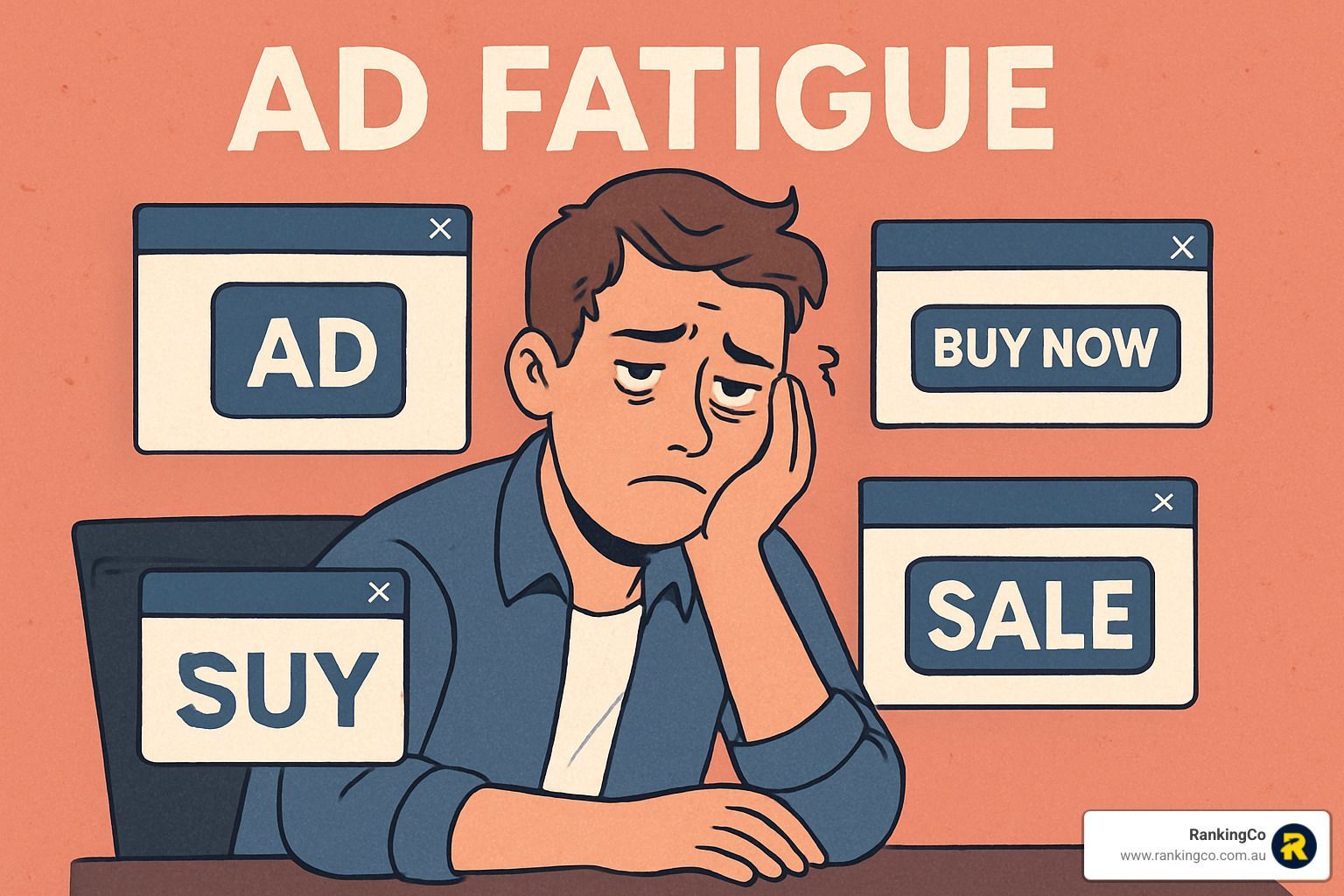
Key Ad Fatigue Metrics to Track
Setting up a dedicated dashboard to monitor ad fatigue can save your campaigns before performance plummets. Focus on tracking CTR trends over both 7-day and 30-day periods to spot gradual declines that might otherwise go unnoticed. Keep a close eye on your impression share too—consistently high percentages mean the same users are seeing your ads repeatedly.
For Display and Video campaigns, frequency metrics become your best friends. Try keeping weekly frequency below 5-7 impressions per user to maintain engagement. Meanwhile, unexplained increases in cost per conversion often reveal that fatigue is eating into your campaign efficiency.
Quality Score declines, particularly in your high-volume keywords, signal that Google has noticed user engagement dropping. For video content, falling view-through and completion rates are dead giveaways that viewers have seen enough.
We recommend creating automated Google Ads rules that alert you when CTR drops by more than 20% compared to the previous period. This simple automation has saved countless campaigns for our Brisbane clients before performance crashes completely.
Ad Fatigue Benchmarks for Australian SMBs
Australian businesses face unique challenges when battling ad fatigue due to our smaller market size. From our experience with local clients across the country, fatigue timelines vary significantly by location and industry.
In metro areas like Sydney, Melbourne and Brisbane, broad-targeting campaigns typically maintain effectiveness for 8-12 impressions before fatigue sets in. However, niche B2B campaigns in these same cities often see engagement drop after just 4-6 impressions due to smaller audience pools.
Regional businesses face even tighter constraints. With limited audience sizes in areas outside major cities, ad fatigue can appear after just 3-5 impressions per user. This makes creative refreshes and audience expansion strategies particularly important for regional Australian SMBs.
Competitive verticals like finance, legal services and real estate experience accelerated fatigue cycles regardless of location. The higher ad density in these spaces means users encounter more competing messages, leading to faster attention burnout.
Understanding these benchmarks gives you realistic expectations about when to refresh creative or adjust targeting in your specific market. The earlier you spot the warning signs, the more effectively you can prevent the performance crashes that ad fatigue inevitably brings when left unchecked.
Platform Nuances: Facebook, TikTok, LinkedIn vs Google
When battling ad fatigue, it's crucial to understand how this digital nemesis behaves differently across platforms. While our focus remains on Google Ads, this cross-platform perspective helps create more effective overall marketing strategies.
Google Ads experiences fatigue in its own unique way. Display and remarketing campaigns typically show the first signs of wear, with frequency building quickly as users browse across the web. Search campaigns face a different challenge—what we might call "keyword blindness" rather than creative fatigue. Because these ads appear when users are actively searching, they maintain relevance longer, but eventually, even the most interested searchers start glossing over familiar ad copy.

Facebook and Instagram ads tend to burn out considerably faster than Google's offerings. Their highly visual nature makes creative staleness immediately apparent, with engagement typically dropping significantly after just 3-5 days of consistent exposure. The scrolling nature of these platforms means users quickly recognise—and subsequently ignore—content they've already seen.
TikTok takes the crown for most rapid wear-out. Its algorithm's efficiency at content delivery means smaller audiences can be completely saturated within 48-72 hours. I've seen Australian fashion brands watch their once-stellar performance metrics plummet after just two days without creative refreshes.
LinkedIn stands at the opposite end of the spectrum, showing the slowest fatigue onset. B2B campaigns often maintain steady performance for weeks or even months. The professional nature of the platform, combined with less frequent usage patterns, creates a naturally longer lifespan for ads.
The key advantage Google holds over social platforms lies in search intent. When someone actively seeks information related to your product or service, they remain somewhat receptive despite repeated exposures. This "protective factor" gives Google Ads campaigns a natural resilience against fatigue that social platforms simply can't match.
Channel-Specific Fatigue Thresholds
Each platform has its own timeline for creative refreshes to maintain optimal performance:
For Google Search, refreshing ad copy every 30-45 days typically maintains performance. This longer window reflects the intent-based nature of search advertising where relevance comes first.
Google Display campaigns need more frequent attention, with creative rotations recommended every 14-21 days. The passive nature of display advertising means visual fatigue sets in faster.
Facebook and Instagram demand vigilance, requiring 3-5 creative variations rotated every 7-10 days. The rapid scroll-and-consume behaviour of users accelerates fatigue dramatically.
LinkedIn offers more breathing room, with 5+ variations needed approximately every 30 days—perfect for B2B marketers with longer sales cycles.
TikTok is the most demanding platform, requiring 10-20 variations every 5-7 days to maintain performance. Its young, content-hungry audience quickly tires of repetition.
For Google Ads specifically, we recommend maintaining at least 3 active expanded text ads per ad group, using responsive search ads with 8+ headline variations, and creating 4-6 different display ad sizes and themes. This variety helps combat fatigue while giving Google's algorithm more options to match user intent.
How Retargeting Accelerates Ad Fatigue
Retargeting campaigns are particularly vulnerable to ad fatigue for several interconnected reasons.
First, you're working with an inherently limited audience size—only people who've previously visited your site. This concentrated targeting means the same users see your ads repeatedly, accelerating fatigue.
Second, retargeting settings often default to aggressive frequency, potentially showing ads dozens of times to the same users. I've audited accounts where users were seeing the same ad 20+ times in a single week—well beyond the point of diminishing returns.
Third, extended cookie windows (typically 30-90 days) create prolonged exposure periods. While a 90-day window might seem logical for capturing long sales cycles, without creative variation, it simply extends the fatigue period.
Finally, cross-platform visibility compounds the problem. When users see identical messaging across Google, Facebook, and other platforms, the cumulative frequency creates an overwhelming sense of being "followed" by your brand.
Research consistently shows retargeting conversions peak around six ad views before declining. Yet many Australian businesses continue bombarding potential customers well beyond this optimal threshold, creating irritation rather than interest.
To combat retargeting fatigue in Google Ads, segment your audience by recency (0-7 days, 8-14 days, 15-30 days) and rotate creative for each segment. Implement sequential messaging that evolves based on exposure time, and set appropriate frequency caps—we typically recommend 3-4 impressions per week for most Australian businesses.
By understanding these platform-specific fatigue patterns, you can create a more resilient cross-channel strategy that maintains performance longer while respecting your audience's attention. For help implementing these strategies across your Google Ads campaigns, our Google Ads management team specialises in keeping campaigns fresh and fatigue-free.
9 Proven Strategies to Prevent & Cure Ad Fatigue
Let's face it—even the most brilliant ad eventually loses its shine. When your audience has seen your message one too many times, engagement plummets and costs soar. But ad fatigue doesn't have to be a death sentence for your campaigns. We've refined these nine strategies through years of helping Australian businesses keep their Google Ads fresh and effective:
- Regular creative refreshes to rekindle audience interest
- Dynamic creative optimisation to automatically serve variety
- Audience expansion to reach untapped viewers
- Automated rules to catch performance drops before they spiral
- Strategic ad scheduling to prevent overwhelming exposure
- Sequential storytelling that evolves with each impression
- Interactive formats to boost engagement
- AI-driven prediction to anticipate fatigue before it hits
- Offer variation to highlight different value propositions
For Google Ads specifically, I've found the magic trio is creative refreshes, smart audience management, and well-configured automated rules. These three approaches deliver the biggest impact for the least effort.
Creative Refreshes that Beat Ad Fatigue
You don't need to reinvent the wheel every time to fight ad fatigue. Even subtle changes can reset the audience's attention and breathe new life into your campaigns.
For Google Search Ads, small text adjustments often work wonders:
Swap your headline positions around for a fresh feel. Change your call-to-action from a passive "Learn More" to an action-oriented "Find Today" or "Find Now." Adding seasonal references or timely hooks can make familiar messaging feel current again. Testing different value angles—highlighting price one week, quality the next, and convenience after that—keeps your message evolving.
For Australian audiences, we've seen remarkable lifts from adding location-specific information. One Brisbane client saw a 28% CTR improvement simply by adding "Brisbane-based experts" to their headline.
For Google Display Ads, visual refreshes create immediate impact:
A simple colour change can work magic—one Sydney retailer saw their CTR jump 42% after changing their display ad background from blue to orange while keeping everything else identical. Updating your featured image while maintaining the same message creates a sense of newness without losing brand consistency. Even testing different ad sizes and formats can reset the fatigue clock.
Dynamic Ads & AI-Driven Rotation
Google's AI-powered tools can do much of the heavy lifting in combating ad fatigue:
Responsive Search Ads (RSAs) are perhaps the most powerful fatigue-fighting tool in your arsenal. By providing multiple headlines and descriptions, you're essentially creating dozens of ad variations that Google automatically tests and optimises. For best results, aim for at least 8-10 truly unique headlines—not just slight variations of the same message. Include a healthy mix of features, benefits, and calls-to-action, and regularly review your combination reports to see which elements are winning.
One Perth accountant we work with saw a 34% improvement in conversion rate after expanding their RSA from the minimum required assets to a robust set of 15 headlines and 4 descriptions.
Responsive Display Ads follow the same principle for visual content. Upload 3-5 images in different aspect ratios, provide multiple text elements, and let Google find the winning combinations. The key is regularly reviewing asset performance and replacing underperforming elements before they drag down the entire ad.
Smart campaigns take this automation even further, using machine learning to adjust creative elements based on early fatigue indicators before performance significantly drops.
Audience Tuning & Smart Targeting
How you manage your audience is just as important as what you show them. Smart audience strategies prevent ad fatigue before it starts:
Expand your reach when frequency metrics start climbing. Create lookalike audiences based on your converters to find fresh prospects with similar characteristics. Gradually broaden your demographic targeting or expand your geographic radius for local campaigns. For one Gold Coast retailer, expanding their radius by just 15 km brought in a wave of new prospects and boosted overall campaign performance by 22%.
Implement smart exclusion lists to prevent bombarding the same people. Exclude recent converters from seeing the same acquisition ads. Create tiered exclusions based on engagement depth—someone who's visited your site five times needs different messaging than a first-time visitor. Use negative keywords strategically to prevent appearing for repetitive searches.
Rotate between audience segments to create natural "cooling off" periods. A Melbourne service business we work with created three audience rotation groups, each active for two weeks with one week off. This rotation created a sustainable exposure pattern that maintained performance over months rather than weeks.
Frequency Caps & Budget Pacing
For Google Display and Video campaigns, proper frequency management is non-negotiable:
Set appropriate frequency caps based on your audience and objectives. Start conservative—for most Australian businesses, 3-4 impressions per week is a good baseline. You can test incremental increases while watching engagement metrics. Different campaign objectives warrant different caps: higher for awareness, lower for conversion-focused campaigns.
Use daily unique reach optimisation in Google Ads to prioritise showing your ads to new users each day. This naturally limits frequency while maximising your audience reach and is particularly effective for awareness campaigns.
Create rule-based budget pacing to prevent overexposure. Set up automated rules that reduce daily budgets when frequency thresholds are exceeded. Implement day-of-week budget adjustments based on historic performance—if Tuesdays consistently show lower engagement, reduce exposure on those days.
Consider dayparting to limit when your ads appear. This prevents all-day exposure to the same users and concentrates your budget during high-performance hours. For a Sydney B2B client, limiting ad delivery to business hours with a slight extension into early evening created natural exposure breaks and improved overall campaign efficiency by 28%.
Cross-Channel Diversification
Varying your media mix helps combat ad fatigue by reaching users in different contexts:
Complement Google Search with Display for a more balanced approach. Search captures active intent while Display builds awareness through different creative formats. This variety reduces perceived repetition and creates more opportunities for diverse messaging.
Incorporate YouTube into your Google campaigns to add rich storytelling opportunities. Video content engages different senses and creates stronger memory pathways for your message. A Brisbane retailer found that adding YouTube pre-roll ads to their existing Search campaign actually improved Search performance by creating multi-channel familiarity without single-channel fatigue.
Consider audio ads through Google's partner network to provide a complete break from visual ad fatigue. Audio reaches users during screen-free moments and creates a different memory pathway for your message—perfect for when eyes are tired but ears are available.
Sequential Storytelling
Instead of fighting ad fatigue, sequential messaging accepts repeated exposure by evolving your story based on user engagement:
For Google remarketing campaigns, structure your messaging journey like this:
- First exposure: Introduce your brand and unique value proposition
- Second exposure: Highlight specific products or services the user viewed
- Third exposure: Present customer testimonials or social proof
- Fourth exposure: Offer incentives or limited-time promotions
- Fifth+ exposure: Address common objections or frequently asked questions
This approach transforms potential fatigue into an engagement opportunity, with each new impression building on previous knowledge rather than merely repeating it.
Implementation requires creating custom audience segments based on ad exposure count, with dedicated ad groups for each sequence stage. Develop creative that explicitly acknowledges previous interactions and adjust your bidding strategy based on sequence position.
Offer & CTA Rotation
Sometimes all you need is a fresh offer or call-to-action to make familiar ads feel new again:
Rotate these CTA approaches in your Google Ads:
- Direct purchase CTAs like "Buy Now" or "Shop Today"
- Information-gathering CTAs such as "Learn More" or "Find Options"
- Value-focused CTAs highlighting "Save 20%" or "Free Shipping"
- Urgency-based CTAs emphasising "Limited Time" or "While Stocks Last"
- Problem-solving CTAs like "Fix Your [Problem]" or "Solve [Issue] Today"
Test different value propositions to keep your message fresh:
- Price advantages and special promotions
- Quality features and durability benefits
- Convenience factors and speed of service
- Expertise credentials and trust signals
- Australian-made advantages or local service benefits
A Sydney financial services firm we work with rotated between three different lead magnets (free guide, calculator tool, and consultation) to maintain fresh messaging while targeting the same keywords. This approach extended their campaign's effective lifespan by nearly 300%.
Continuous Monitoring & Automation
Catching ad fatigue early requires vigilant monitoring and smart automation:
Set up automated alerts for early warning signs:
- CTR drops exceeding 15% week-over-week
- Frequency exceeding predetermined thresholds
- Conversion rate declines of 20%+ from baseline
- Quality Score decreases for key terms
Leverage Google Ads scripts to take automatic action:
- Pause ads when fatigue metrics trigger warning thresholds
- Schedule creative rotation based on impression milestones
- Adjust budgets when frequency caps are reached
- Generate regular performance reports highlighting potential fatigue indicators
Consider AI-powered prediction tools that identify fatigue patterns before they impact performance, recommend optimal timing for creative refreshes, and suggest audience adjustments based on saturation signals.
Frequently Asked Questions about Ad Fatigue
How quickly can ad fatigue set in?
Let's be honest – we've all hit that point where we mutter "not this ad again" under our breath. But the timeline for when ad fatigue kicks in isn't one-size-fits-all. It varies dramatically depending on what you're running and who you're targeting.
For Google Ads specifically (since that's what we're focusing on here), the timing typically breaks down like this:
With Search campaigns, most Australian businesses see performance dips after about 3-4 weeks of showing the same ads to the same audience. Though if you're targeting people who search frequently for your keywords (like property hunters or job seekers), they might mentally tune out much faster.
Display campaigns tend to show the warning signs earlier – usually within 10-14 days. Those banner ads just don't stay fresh for long, especially when they follow users around the internet.
Video campaigns have an even shorter shelf life, with engagement often dropping after just 7-10 days. We've seen pre-roll ads go from attention-grabbing to skip-button-triggering in less than a week.
The quickest to fatigue? Remarketing campaigns. When you're specifically targeting people who already know you, they'll notice repetition faster – sometimes within just 5-7 days.
Remember though, it's not really about days on the calendar, but how frequently someone sees your ad. A campaign hitting users three times daily will burn out much faster than one they encounter twice weekly.
Does audience size change fatigue speed?
Absolutely it does – and this is particularly relevant for Australian businesses where our market is simply smaller than places like the US or UK.
Smaller audiences (under 10,000 users) typically experience fatigue 2-3 times faster than larger audiences. It's simple mathematics – fewer people means each person sees your ad more frequently, accelerating the fatigue cycle.
This gets even more pronounced when you're targeting niche B2B audiences in Australia. If you're selling specialised manufacturing equipment in a specific region, you might have just a few hundred potential customers. They can reach saturation points within days rather than weeks.
Local businesses in regional areas face this challenge constantly. A plumber in Toowoomba has a much smaller potential audience than one in Brisbane, meaning their ads might start losing effectiveness much sooner.
This doesn't mean you should artificially expand your audience beyond your actual target market. Instead, it means you need to be more strategic with your creative rotation and frequency management to compensate for the limited reach. Quality over quantity becomes even more critical when your audience pool is naturally restricted.
Can I pause and restart the same ad later?
It's a bit like trying to tell the same joke to the same person – the timing matters!
Pausing and restarting ads can indeed provide a reset for ad fatigue, but the effectiveness depends on how long you wait:
Short breaks of just 1-2 weeks typically don't do much. Your audience still remembers your ads, and the fatigue picks right back up where it left off.
Medium pauses of 1-2 months can be quite effective, especially if you have a seasonal business. This gives your audience enough time to "forget" the specific creative, even if they remember your brand.
Long pauses of 3+ months often allow for nearly complete performance recovery. At this point, even if users recognise your brand, the specific creative feels fresh again.
For Google Ads specifically, here's what we recommend based on our experience across Australian markets:
Create entirely new ads rather than simply pausing and resuming the same ones. The effort is worth it.
If you must reuse creative elements, update at least 30% of the content – swap out images, refresh headlines, or change your call to action.
Consider adding seasonal or timely elements that justify why the ad is appearing again ("Back for summer" or "New 2024 models").
When reintroducing paused creative, it's often worth resetting your audience targeting to capture new potential customers who haven't seen the ad before.
One of our Melbourne retail clients successfully brought back their core creative after a 10-week pause, but only after refreshing all headlines and updating imagery to reflect the new season. The performance nearly matched their original launch metrics, proving that absence really can make the heart grow fonder – even in advertising!
Open up Your Potential – Get Ranking with RankingCo
Let's face it – ad fatigue happens to the best of us. It's like that catchy song you loved until it played on every radio station for weeks. But unlike that unavoidable earworm, you can actually do something about ad fatigue in your Google Ads campaigns.
Throughout this guide, we've explored how ad fatigue sneaks up on even the most carefully planned campaigns. Those declining click-through rates and rising costs aren't just random fluctuations – they're telling you your audience needs something fresh.
The good news? You're now armed with practical strategies to keep your ads engaging:
- Monitor those performance metrics like a hawk. Don't wait for performance to plummet before taking action – those early warning signs are your friends.
- Keep your creative assets feeling fresh and relevant. Sometimes even small tweaks can breathe new life into a campaign that's starting to lose its spark.
- Frequency caps are your allies, especially in Australia's smaller market where audiences see your ads more often. What works for massive international campaigns often needs adjustment for our local audiences.
- Let Google's clever tools do some heavy lifting. Responsive Search Ads with multiple headlines and descriptions give the algorithm room to find winning combinations before fatigue sets in.
- Think of your audience like guests at a dinner party – you wouldn't serve them the same meal every time they visit. Segment and rotate your audiences to prevent that "oh no, not this again" feeling.
- Mix up your channels and touchpoints. When people see you in different contexts, it keeps your brand feeling dynamic rather than repetitive.
- Tell a story that evolves. Sequential messaging builds on previous interactions instead of repeating the same information, creating a journey rather than a loop.
- Test different offers and calls-to-action to maintain freshness. Sometimes it's not the creative that's tired – it's the proposition itself.
At RankingCo, we help businesses across Australia implement these strategies to keep campaigns fresh and effective. From Brisbane to Perth, our team specialises in creating Google Ads campaigns that resist fatigue through intelligent planning and hands-on management.
We understand the unique challenges Australian businesses face with smaller audience pools and higher frequency rates. Our approach combines proven fatigue-fighting techniques with local market knowledge to keep your campaigns performing at their best.
Ready to revitalise your digital advertising and overcome ad fatigue? Our Digital Marketing Services in Brisbane and throughout Australia can help you develop campaigns that maintain their effectiveness no matter how competitive your market becomes.
Don't let ad fatigue drain your marketing budget. Let's work together to keep your audience engaged and your Google Ads investments delivering consistent results.
